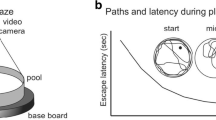Abstract.
The hypothesis that meanings originate from discrimination tasks, in which an individual attempts to categorize N objects using a set of M sensory channels, is examined within a quantitative statistical perspective. Failure in discrimination triggers the refinement of a randomly-chosen sensory channel, starting thus an ongoing process, termed discrimination game, that ends only when all objects are differentiated. We show that the expected number of trials of a discrimination game diverges in the case of a single channel and scales with the power N2/M for M ≥2.
Similar content being viewed by others
References
P. Bloom, How children learn the meaning of words (MIT Press, Cambridge, 2000)
S. Harnard, Physica D 42, 335 (1990)
F. de Saussure, Course in General Linguistics, translated by Wade Baskin (McGraw-Hill Book Company, New York, 1966)
L. Steels, J.-C. Baillie, Rob. Aut. Syst. 43, 163 (2003)
A. Cangelosi, D. Parisi, in Simulating the Evolution of Language, edited by A. Cangelosi, D. Parisi (Springer, London, 2002), pp. 3–28
L. Steels, in Proceedings Second International Conference on Multi-Agent Systems, edited by M. Tokoro (AAAI Press, Menlo Park, 1996), pp. 338–344
A.D.M. Smith, Artificial Life 9, 557 (2003)
A.D.M. Smith, in Proceedings 7th European Conference on Artificial Life, edited by W. Banzhaf, T. Christaller, P. Dittrich, J.T. Kim, J. Ziegler, Lecture Notes in Artificial Intelligence (Springer, Berlin, 2003), Vol. 2801, pp. 499–506
W. Feller, An Introduction to Probability Theory and Its Applications, Vol. I (Wiley, New York, NY, 1968)
J.F. Fontanari, L.I. Perlovsky, in Proceedings International Conference on Integration of Knowledge Intensive Multi-Agent Systems, edited by C. Thompson, H. Hexmoor (IEEE Press, Boston, 2005), pp. 405–410
L.I. Perlovsky, Neural Networks and Intellect: Using Model-Based Concepts (Oxford University Press, Oxford, 2001)
D.E. Barton, F.N. David, J. Roy. Stat. Soc. B 18, 79 (1956)
Author information
Authors and Affiliations
Rights and permissions
About this article
Cite this article
Fontanari, J. Statistical analysis of discrimination games. Eur. Phys. J. B 54, 127–130 (2006). https://doi.org/10.1140/epjb/e2006-00400-x
Received:
Published:
Issue Date:
DOI: https://doi.org/10.1140/epjb/e2006-00400-x




